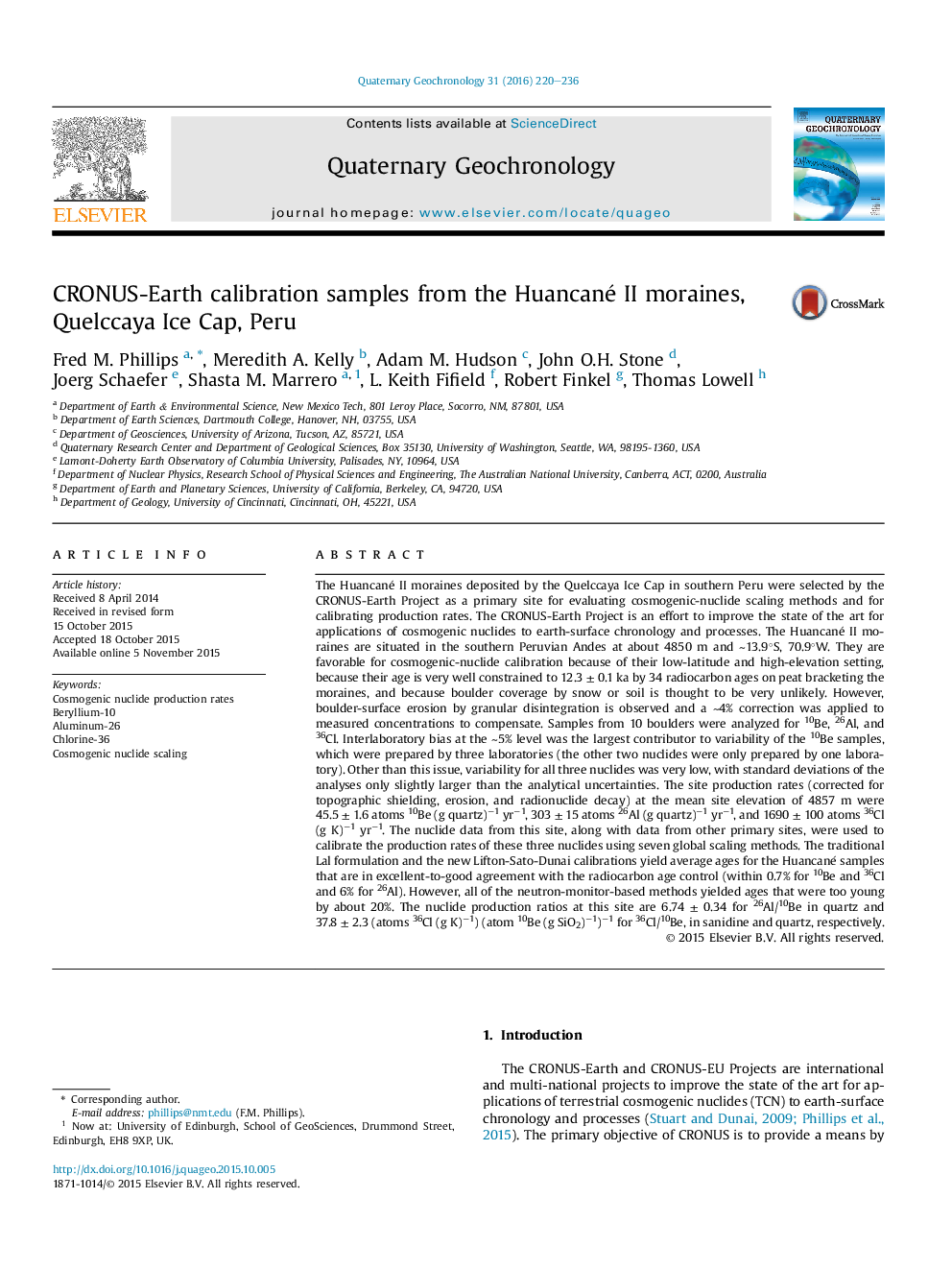| کد مقاله | کد نشریه | سال انتشار | مقاله انگلیسی | نسخه تمام متن |
|---|---|---|---|---|
| 6442523 | 1639845 | 2016 | 17 صفحه PDF | دانلود رایگان |
عنوان انگلیسی مقاله ISI
CRONUS-Earth calibration samples from the Huancané II moraines, Quelccaya Ice Cap, Peru
دانلود مقاله + سفارش ترجمه
دانلود مقاله ISI انگلیسی
رایگان برای ایرانیان
موضوعات مرتبط
مهندسی و علوم پایه
علوم زمین و سیارات
ژئوشیمی و پترولوژی
پیش نمایش صفحه اول مقاله

چکیده انگلیسی
The Huancané II moraines deposited by the Quelccaya Ice Cap in southern Peru were selected by the CRONUS-Earth Project as a primary site for evaluating cosmogenic-nuclide scaling methods and for calibrating production rates. The CRONUS-Earth Project is an effort to improve the state of the art for applications of cosmogenic nuclides to earth-surface chronology and processes. The Huancané II moraines are situated in the southern Peruvian Andes at about 4850 m and â¼13.9°S, 70.9°W. They are favorable for cosmogenic-nuclide calibration because of their low-latitude and high-elevation setting, because their age is very well constrained to 12.3 ± 0.1 ka by 34 radiocarbon ages on peat bracketing the moraines, and because boulder coverage by snow or soil is thought to be very unlikely. However, boulder-surface erosion by granular disintegration is observed and a â¼4% correction was applied to measured concentrations to compensate. Samples from 10 boulders were analyzed for 10Be, 26Al, and 36Cl. Interlaboratory bias at the â¼5% level was the largest contributor to variability of the 10Be samples, which were prepared by three laboratories (the other two nuclides were only prepared by one laboratory). Other than this issue, variability for all three nuclides was very low, with standard deviations of the analyses only slightly larger than the analytical uncertainties. The site production rates (corrected for topographic shielding, erosion, and radionuclide decay) at the mean site elevation of 4857 m were 45.5 ± 1.6 atoms 10Be (g quartz)â1 yrâ1, 303 ± 15 atoms 26Al (g quartz)â1 yrâ1, and 1690 ± 100 atoms 36Cl (g K)â1 yrâ1. The nuclide data from this site, along with data from other primary sites, were used to calibrate the production rates of these three nuclides using seven global scaling methods. The traditional Lal formulation and the new Lifton-Sato-Dunai calibrations yield average ages for the Huancané samples that are in excellent-to-good agreement with the radiocarbon age control (within 0.7% for 10Be and 36Cl and 6% for 26Al). However, all of the neutron-monitor-based methods yielded ages that were too young by about 20%. The nuclide production ratios at this site are 6.74 ± 0.34 for 26Al/10Be in quartz and 37.8 ± 2.3 (atoms 36Cl (g K)â1) (atom 10Be (g SiO2)â1)â1 for 36Cl/10Be, in sanidine and quartz, respectively.
ناشر
Database: Elsevier - ScienceDirect (ساینس دایرکت)
Journal: Quaternary Geochronology - Volume 31, February 2016, Pages 220-236
Journal: Quaternary Geochronology - Volume 31, February 2016, Pages 220-236
نویسندگان
Fred M. Phillips, Meredith A. Kelly, Adam M. Hudson, John O.H. Stone, Joerg Schaefer, Shasta M. Marrero, L. Keith Fifield, Robert Finkel, Thomas Lowell,